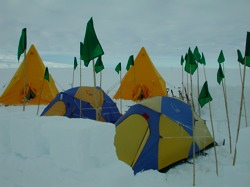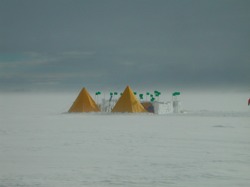GOLF 4-3-9 Antarctica Expedition 2008
Report -- Sunday 16 November 2008 -- The Wind is Everything!
GOLF 4-3-9 Antarctica Expedition 2008 |

Intuitively temperature seems to be the most worrisome aspect of Antarctic weather. Wrong! The wind is the most important factor. It can be quite pleasant to be in sunny calm weather at -40° (the same in degrees °F or °C). Barely freezing conditions, however, can be hell when the wind is blowing hard. So what is it about the winds in Antarctica, and what does it do to the people (and the rocks) of Antarctica? How do we deal with these winds?
Winds can be fierce everywhere in Antarctica and reach hurricane force. After all, this is billed as "the windiest continent". The highest recorded wind velocity in Antarctica is 199mph (327km/h) at Dumont d'Urville in July of 1972. This is comparable to the strongest wind gust recorded on the surface of the earth, of 231 mph (371km/h) at Mount Washington, New Hampshire (USA) on 12 April 1934. The wind is predictable enough so that wind turbines are now being used to generate electricity. A Large New Turbine Array is under construction by the New Zealanders on Ross Island now.

The combined physical force and the chilling effect can substantially limit what we can do in the field and on-station. Almost any outdoor activity can become very difficult in windy conditions, in particular the ones that need dexterity (tying knots, marking samples), and it is very difficult to manage your breath that tends to make icicles on beards, turn scarves into solids or render ones sunglasses or goggles useless. Helicopters stop working with sling loads at winds exceeding 30 mph and your mountain tent will fly away or get shredded to pieces at 75 mph (which does not occur that often, luckily). At McMurdo base, there is a weather code system, where the worst is "Condition 1" when nobody is allowed to leave any building, This is the ONLY case when it is actually advantageous if your dorm room is in the same building as the galley.
There are two main wind types in the Antarctic Dry Valleys, in particular the Katabatic and the Anabatic winds. The Katabatic Winds form when very cold and dense air "falls" off the polar plateau into the valleys. Katabatic winds typically blow during the nighttime hours and blow down the valleys towards the oceans. There are also winds that travel up valley, from the ocean side (typically during the daytime), and they are called Anabatic winds. The Katabatic winds can be very strong and blow hard for hours at a time.

These winds are so strong, they mobilize a lot of sand and small rocks that shape exposed rocks into fantastic shapes, called ventifacts. Ventifacts are particularly common where the wind can freely move over unobstructed landscape or where it is funneled between major obstacles, such as mountain ranges or through gorges.
During our stay in Taylor Valley one of the mountain tents was blown over by these winds. The traditional tent for polar exploration is a Scott tent named for the tents that Scott used during its early exploration days over 100 years ago. These are four-sided pyramid shaped double walled tents made from heavy canvas. They have a door that is an extended tunnel to keep out blowing snow and a flange around the base so snow can be packed down tight on the edges. They are tall enough so you can stand in them which is very nice to be able to when you are trying to change your very bulky ECW clothing, Scott tents also have controllable vents near their top and they are not made from highly flammable materials so you can safely cook in them. These advantages are the reasons why the Scott tents are still very commonly used, even though they have been mostly replaced now by the lighter and smaller mountain tents.
Another Antarctic wind-associated idea is the concept of wind-chill. An early explorer of the Antarctic and a Boy Scout, Paul Siple, coined the term "wind-chill" in 1939. This term defined the time it would take to freeze a cylinder of water and he found that the wind speed was an important factor. The formula that the weather service uses now is slightly different but the idea is the same. The freezing effect of wind is worst when skin is directly exposed to high winds. That is why when the weather service talks about freezing skin in wind-chill conditions and they use exposed skin as a basis for determining an apparent wind chill temperature.
| GOLF 4-3-9 Antarctica Expedition |